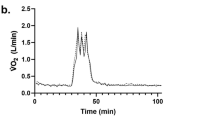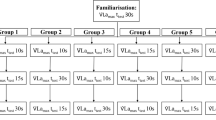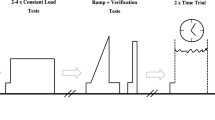Abstract
To assess whether the ability to demonstrate a plateau in oxygen consumption \(({\mathop V\limits^{.}}\hbox{O}_{2})\) could be related to adaptation to exercise, the data obtained over a period of 10 years on 94 elite oarsmen who had participated in annual testing were re-evaluated. The test consisted in an incremental step protocol until volitional exhaustion. \({\mathop V\limits^{.}}\hbox{O}_{2},\) heart rate (HR), blood lactate ([La]b) and respiratory exchange ratio (RER) were measured at each step. The maximal oxygen consumption \(({\mathop V\limits^{.}}\hbox{O}_{\rm 2max}),\) the power corresponding to \({\mathop V\limits^{.}}\hbox{O}_{\rm 2max}(\hbox{P}_{\rm amax})\) and the maximal power achieved (Ppeak) were recorded. Thirty-eight oarsmen achieved a \({\mathop V\limits^{.}}\hbox{O}_{2}\) plateau and were designated as Pla; 56 did not and were designed as N-Pla. The Pla and N-Pla \({\mathop V\limits^{.}}\hbox{O}_{\rm 2max},\,\hbox{P}_{\rm amax}\) and maximal HR values were similar. In comparison with N-Pla, the Pla group displayed a rightward shift of the [La]b versus power curve, accounted for by both the increased percentage of \({\mathop V\limits^{.}}\hbox{O}_{\rm 2max}\) corresponding to 4 mmol l−1 and the decreased value of [La]b corresponding to Pamax (P < 0.05). Pla oarsmen attained a higher Ppeak expressed as % of Pamax (P < 0.05) and also showed better ergometer performance (P < 0.05). In a sub-group of 53 oarsmen constituted on the basis of Pamax values close to 400 W, for a given power output, the Pla subjects had significantly lower HR, RER, and [La]b values at each sub-maximal stage of the test. These results suggest that achieving a \({\mathop V\limits^{.}}\hbox{O}_{2}\) plateau during completion of an incremental step protocol accounts for greater muscle ability to maintain homeostasis during exercise. These differences give the oarsmen an advantage in rowing competitions.



Similar content being viewed by others
References
Åstrand PO, Ryhming I (1954) A nomogram for calculation of aerobic capacity (physical fitness) from pulse rate during sub-maximal work. J Appl Physiol 7:218–221
Bourdin M, Messonnier L, Hager J-P, Lacour J-R (2004) Peak power output predicts rowing ergometer performance in elite male rowers. Int J Sports Med 25:368–373
Busso T, Chatagnon M (2006) Modelling of aerobic and anaerobic energy production in middle-distance running. Eur J Appl Physiol 97:745–754
Day JR, Rossiter HB, Coats EM, Skasick A, Whipp BJ (2003) The maximally attainable \({\mathop V\limits^{.}}\hbox{O}_{2}\) during exercise in humans: the peak vs. maximum issue. J Appl Physiol 95:1901–1907
di Prampero PE, Ferretti G (1999) The energetics of anaerobic muscle metabolism: a reappraisal of older and recent concepts. Respir Physiol 118:103–115
Doherty M, Nobbs L, Noakes TD (2003) Low frequency of the “plateau phenomenon” during maximal exercise in elite British athletes. Eur J Appl Physiol 89:619–623
Fitts RH (1994) Cellular mechanisms of muscle fatigue. Physiol Rev 74: 49–93
Howley ET, Bassett DR Jr, Welch HG (1995) Criteria for maximal oxygen uptake: review and commentary. Med Sci Sports Exerc 27:1292–1301
Kuipers H, Verstappen FTJ, Keizer HA, Geurten P, van Kranenburg G (1985) Variability of aerobic performance in the laboratory and its physiologic correlates. Int J Sports Med 6:197–200
Maksud MG, Coutts KD (1971) Comparison of a continuous and discontinuous graded treadmill test for maximal oxygen uptake. Med Sci Sports 3: 63–65
McArdle WD, Katch FI, Pechar GS (1973) Comparison of continuous and discontinuous treadmill and bicycle tests for max Vo2. Med Sci Sports 5: 156–160
Messonnier L, Freund H, Bourdin M, Belli A, Lacour J-R (1997) Lactate exchange and removal abilities in rowing performance. Med Sci Sports Exerc 29:396–401
Messonnier L, Freund H, Denis C, Dormois D, Dufour A-B, Lacour J-R (2002) Time to exhaustion at \({\mathop V\limits^{.}}\hbox{O}_{\rm 2max}\) is related to the lactate exchange and removal abilities. Int J Sports Med 23:433–438
Mitchell JH, Sproule BJ, Chapman CB (1958) The physiological meaning of the maximal oxygen intake test. J Clin Invest 37:538–547
Noakes TD, St Clair Gibson A (2004) Logical limitations to the “catastrophe” models of fatigue during exercise in humans. Br J Sports Med 38:648–649
Rossiter HB, Kowalchuk JM, Whipp BJ (2006) A test to establish maximum O2 uptake despite no plateau in the O2 uptake response to ramp incremental exercise. J Appl Physiol 100:764–770
Rowell L (1984) Reflex control of regional circulations in humans. J Auton Nerv Syst 11:101–114
Rowell LB, O’Leary DS (1990) Reflex control of the circulation during exercise: chemoreflexes and mechanoreflexes. J Appl Physiol 69:407–418
Snoeckx L, Abeling H, Lambregts J, Schmitz J, Verstappen F, Reneman R (1983) Cardiac dimensions in athletes in relation to variations in their training program. Eur J Appl Physiol 52:20–28
St Clair Gibson A, Lambert MI, Hawley JA, Broomhead SA, Noakes TD (1999) Measurement of maximal oxygen uptake from two different laboratory protocols in runners and squash players. Med Sci Sports Exerc 31: 1226–1229
Steinacker J (1993) Physiological aspects of training in rowing. Int J Sports Med 14:S3-S10
Taylor HL, Buskirk E, Henschel A (1955) Maximal oxygen intake as an objective measure of cardio-respiratory performance. J Appl Physiol 8: 73–80
Wagner PD (2000) New ideas on limitations to \({\mathop V\limits^{.}}\hbox{O}_{\rm 2max}.\) Exerc Sport Sci Rev 28:10–14
Welch HG, Pedersen PK (1981) Measurement of metabolic rate in hyperoxia. J Appl Physiol 51:725–731
Whipp BJ, Davis JA, Torres F, Wasserman K (1981) A test to determine parameters of aerobic function during exercise. J Appl Physiol 50:217–221
Author information
Authors and Affiliations
Corresponding author
Rights and permissions
About this article
Cite this article
Lacour, JR., Messonnier, L. & Bourdin, M. The leveling-off of oxygen uptake is related to blood lactate accumulation. Retrospective study of 94 elite rowers. Eur J Appl Physiol 101, 241–247 (2007). https://doi.org/10.1007/s00421-007-0487-7
Accepted:
Published:
Issue Date:
DOI: https://doi.org/10.1007/s00421-007-0487-7




